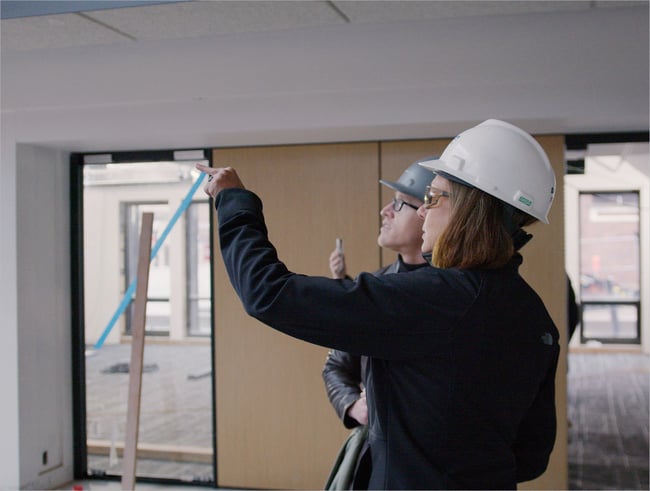What to Expect from Your Architect After Construction

The first year in a new building can present challenges. Between punch list items, warranties, and commissioning, there is plenty on your plate as you settle into your new environment. You are likely ready to get back to your normal operations.
We believe in setting realistic expectations for each phase of the architectural process—including the period after construction. As you ease into your new space, your architect will be available to answer questions and facilitate communication between parties.
This article will discuss the typical process for transitioning from construction to occupancy and explain what you can expect from your architect at each step.
Substantial Completion
Occupancy is the final phase of the architectural process. Contrary to popular belief, this phase does not mean the building is “done.” Instead, it starts when your architect writes a letter of Substantial Completion.
At this point, your architect will visit the site and create a punch list of items the contractor needs to address to reach Final Completion. Often, these items include minor repairs, like fixing drywall damaged during construction. Officials from your jurisdiction will also visit the site to perform a walkthrough and issue a Certificate of Occupancy.
With these documents issued, you can start moving Furniture, Fixtures, and Equipment (FF&E) and occupy the space. The contractor’s warranty will also begin at Substantial Completion.
Although you can occupy the space, the contractor will likely remain on site over the coming months to complete the punch list.

At Substantial Completion, your architect will create a punch list.
Punch List Items and Final Completion
On most projects, it takes 30-60 days to complete punch list items. Some building owners wait until after the punch list is complete to start operations in the new building, while others occupy the space with the contractor on site.
You will hold a 5% retainage during this time that you will pay once the punch list is complete. If (for whatever reason) the contractor does not finish the punch list, you can use the retainage to hire someone to finish the job.
Once the contractor finishes work, your architect will do a final walkthrough and issue a Certificate of Final Completion.
Warranties
A one-year contractor warranty is standard for most construction projects. During this time, you can ask the contractor to address anything that isn’t performing properly.
Specific systems—like roofs, cladding, and mechanical systems—will have separate warranties. This information will be available in an Operations and Maintenance manual that your architect will provide toward the end of construction.
Around the ten-month mark, your architect will contact you to remind you of the contractor’s warranty and to address any issues before it expires. While you can contact the contractor directly, it helps to keep your architect in the loop. The design team can track the issue and ensure the contractor follows up.
For major repairs—especially those involving product vendors—contact your architect first so they can investigate the issue and facilitate communication between all parties.
Post-Occupancy Evaluation
Around the ten-month mark, your architect may also ask to perform a post-occupancy evaluation. Evaluations are sent to building occupants and provide an opportunity to reflect on the project’s goals.
The collected data helps your architect evaluate the design’s performance and the project’s overall success. Occasionally, a post-occupancy evaluation may highlight an issue that needs to be addressed. For example, a lack of thermal comfort may point to a mechanical system issue.

Post-occupancy evaluations are a chance to reassess project goals.
Commissioning and Building Performance Data
Often, building commissioning continues into the first year of building operations. While commissioning agents are involved in construction, they will continue to check systems once they are up and running to ensure everything is working properly.
Depending on your project goals, your architect may monitor building performance. For building rating systems like LEED, your architect will contact your energy provider to get the necessary performance data.
Other rating systems may have a different approach. The Living Building Challenge (LBC) certifies projects after the first operational year. This year begins once all systems are running properly. Your architect will stay in contact with you throughout this time to collect the needed metrics.
Continuing the Architect-Client Relationship
Throughout the first year of operation, your architect will also stay in touch to schedule photography and notify you of any award opportunities. Beyond awards offered through the American Institute of Architects (AIA), your architect may look for opportunities within your industry.
Your building is an embodiment of your values and an investment in your future. Ideally, your architect will continue the relationship by helping you find opportunities to gain recognition and celebrate your accomplishment.
Even after this first year of occupancy comes to a close, your architect is available to answer questions. Whether you need product warranty information, a vendor contact, or a copy of your plan set, your architect can help.
The architect-client relationship is long-lasting—spanning well beyond the initial design of the building. It is important to find someone who is committed to your experience, understands your goals, and aligns with your values. Learn how to find alignment by reading about the best questions to ask when hiring an architect.